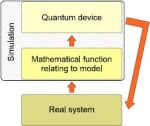EPJ Quantum Technology Highlight - Quantum simulators explained
- Details
- Published on 25 July 2014

Everything you ever wanted to know about quantum simulators has been summed up in a new review from EPJ Quantum Technology
As part of a new Thematic Series on Quantum Simulations, the open access journal EPJ Quantum Technology has just published an overview of what a quantum simulator is, namely: a device that actively uses quantum effects to answer questions on model systems. This review, published by Tomi Johnson and colleagues from the Centre for Quantum Technologies in Singapore and the University of Oxford, UK, outlines various approaches used in quantum simulators.
Specifically, the authors focus on the difference between the purpose of operations referred to as ‘simulation’ and ‘computation’. This distinction, they argue, is related to the purpose of an operation, our level of confidence in and expectations with regard to its accuracy.
They then explain the role of simulations in science, in particular, how simulation reveals information about a mathematical function or model in relation to a system. This approach is reminiscent of physicist Richard Feynman’s definition of simulation, which is akin to using a physical device to learn about a real physical system.
Such simulation of the function of a system only takes its full significance when compared with the outcome of the same function on a real-life system of interest. The outcome helps decide whether or not the model accurately represents the real system. If the representation is thought to be accurate, the quantum simulator can then loosely be considered to be a simulator for the system of interest.
Finally the authors also explain the threshold between quantum and classical simulations. In this context, Johnson and colleagues suggest that there are many more questions pertaining to the work of simulators that need to be answered. These include: Can we predict in advance where the results of quantum simulators are more sensitive to errors? How does this overlap with the regimes of classical simulability?





